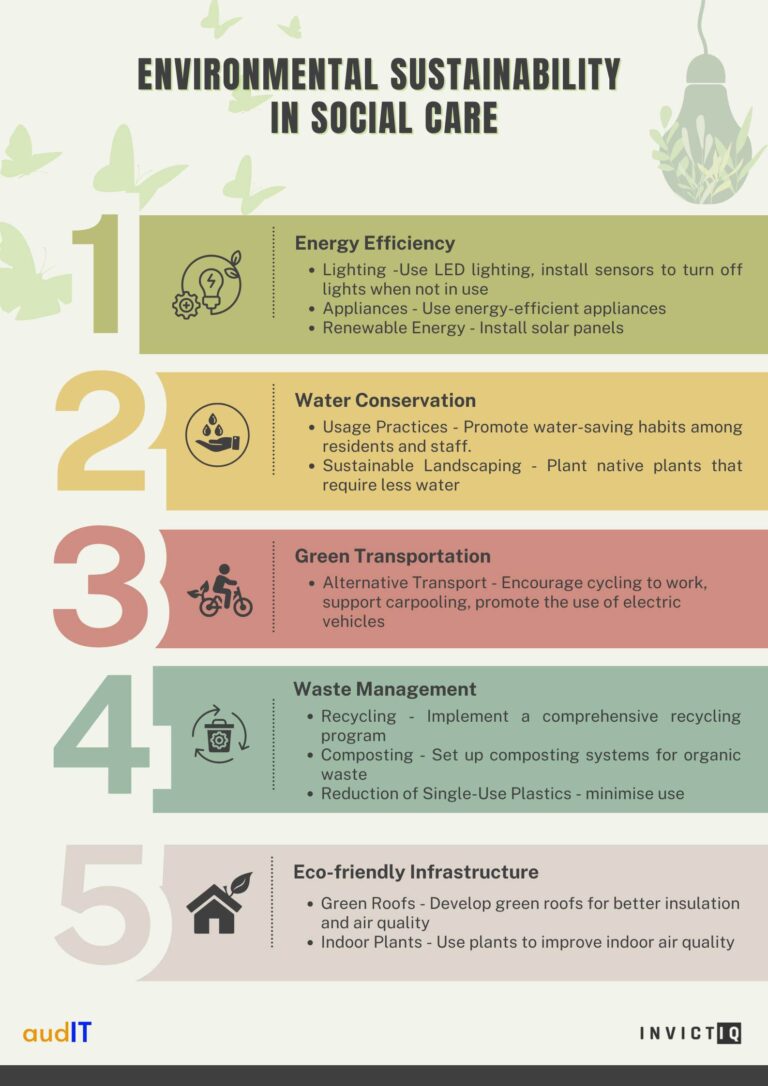@2021 invictIQ is a venture by Sprint Consultancy. All rights reserved. Privacy Policy.

Meeting the new Sustainability Quality Statement
by Mark Topps
One of the biggest changes with the new CQC Single Assessment Framework was the introduction of services being inspected against their Sustainability. I don’t think anyone was surprised it was included, however there were a number of questions about what you should be doing to meet this Quality Statement. For the first year, Sustainability within adult social care is not be inspected, however time is ticking, and the CQC will soon be knocking on providers doors and asking for evidence, so we need to get prepared! I have been working closely with InvictIQ to produce some useful tools to help you and your teams get prepared and here are my top 5 tips to get your organisation inspection ready in terms of meeting the new sustainability quality statement.
1. Estimate your carbon footprint to establish a baseline
Establishing your current carbon footprint is essential to then determine the course of action you want to make within your organisation to reduce these. A carbon footprint is an environmental indicator that represents the amount of greenhouse gases (GHGs), expressed as CO2 equivalents, that are emitted directly or indirectly as a result of a specific activity. This sounds confusing, however there are a number of tools online that you can use for free to determine your organisations footprint. One that was developed by Department for Environment, Food, and Rural Affairs (DEFRA) can be found here. Another useful tool is the UK Business Climate Hub website which provides recommendations and advice to help you to develop your net zero plan. Tailored to health and social care services, the website includes practical information of what to consider making essential savings.
The three biggest areas to focus on are:
- Your energy usage – electricity and gas consumption.
- General waste that ends up in landfill.
- Transport – staff, company owned vehicles and delivery services
2. Implement training, awareness and resources on sustainability into your service
Implementing training, awareness and resources on sustainability is not only crucial for fostering a culture of environmental responsibility within your organisation but it will ensure that your team have the knowledge and tools to make eco-friendly decisions and reduce the organisation and their environmental impact. Be mindful when sourcing training that it meets the needs of your organisation, and ensure you back this up with a Sustainability Policy and Procedure. Keep an eye on the governments bootcamp training website as these offer reduced training courses across the country. You can read more here
3. Develop a sustainability plan, including a policy
We should expect the CQC two be looking at what we are doing as a provider to incorporate renewable energy, sustainable transport and environmentally friendly initiatives. I have no doubt that when the CQC begin scoring sustainability as part of their inspections that they will not want to see policies and procedures, success stories, future pipeline plans and to speak to staff about their understanding and support.
4. Review processes to ensure they include green and sustainable practices
I would ensure that as part of your future plan, you have documented how you will review your processes to ensure you are more carbon efficient. Some ways Some ideas of the changes you consider making and documenting as evidence would be:
- Reviewing your procurement processes to incorporate environmental sustainability considerations.
- Switch energy providers to a green tariff
- Review your waste management procedures, look at recycling initiatives.
- Install a smart meter
- Check windows to ensure good insulation
- Install LED light bulbs
- Review rotas (homecare) to ensure routes are optimised to reduce travel
- I co-created the infographic (see right) with InvictIQ which gives ideas on what you could implement
Digitising compliance/ feedback management is a crucial step towards sustainability, significantly reducing paper usage and streamlining processes to minimise environmental impact. With Audit On Cloud by InvictIQ, organisations can embrace eco-friendly practices while enhancing efficiency and accuracy in their audit and feedback operations.
5. Review supply chains
With so much of our process is relying on others, it is important that we review our supply chains. Make a list of the companies that deliver services to your door, such as food, PPE, Amazon etc. Reviewing our supply chains will evidence how we are ensuring we are ethically sourcing and attempting to minimise environmental impact. Perhaps you could look at bulk ordering PPE/cleaning products to save deliveries and organisations fuel consumption, could you have an Amazon ordering day or combine delivery dates to prevent multiple deliveries across the week etc.
We still have a couple of months until the CQC begin to score the sustainability quality statement and therefore this is not something that you need to dive straight into. Involve your team, review your current processes and formulate a road map but the changes you wish to implement and remember your small changes will make big environmental impacts.
MORE ARTICLES


Mark Topps is a social care leader who has worked in the care industry since 2004 and is currently working as a regional support manager. He regularly advocates, appearing on television, radio and podcasts and has started many campaigns for change in legislation and culture within the industry. Mark is the co-founder of The Caring View which is a social care podcast, YouTube show and free resource initiative for the sector. He also co-founded The Health and Social Care Club, which is an audio event hosted on LinkedIn. Mark is also the social media and marketing director at the National Association of Care and Support Workers.
Share
Sign up for our newsletter
